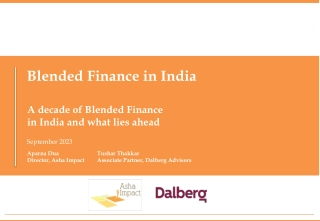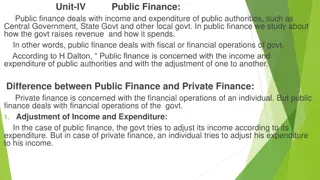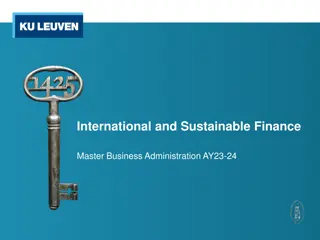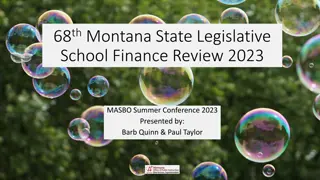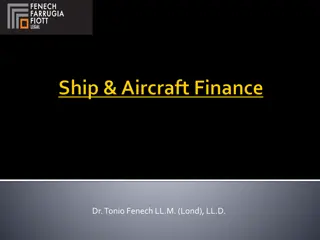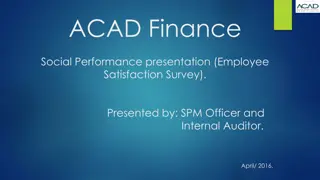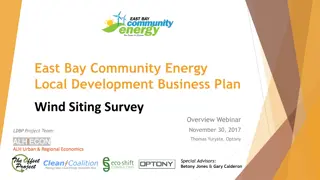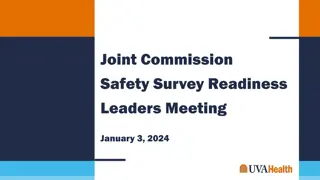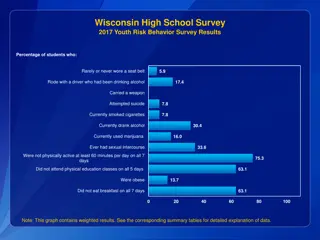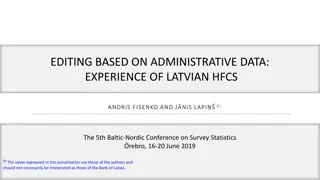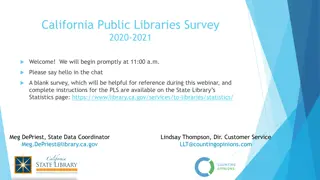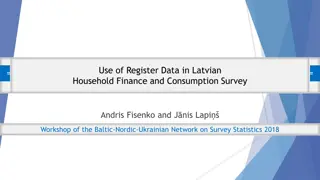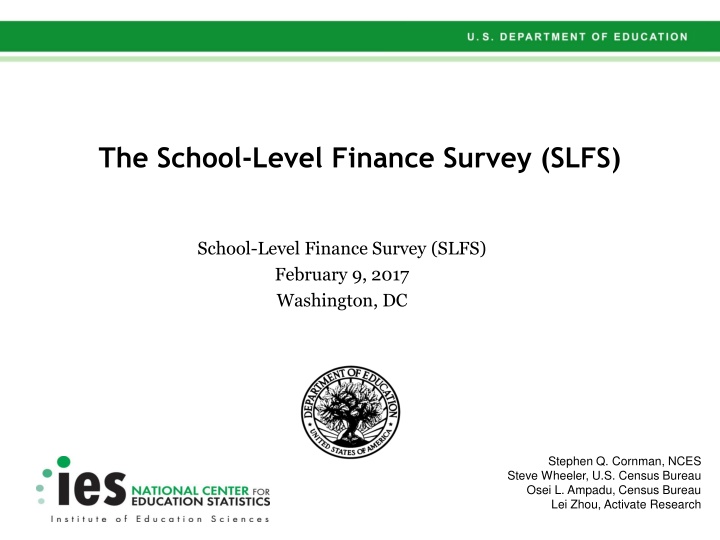
School-Level Finance Survey (SLFS) Overview and Participation
Explore the School-Level Finance Survey (SLFS) initiative, including the pilot program, full-scale data collection, participating states, variables like personnel and non-personnel expenditures, and the benefits of participation. Learn how SLFS aims to enhance data quality at the school level and expand knowledge for state fiscal coordinators.
Download Presentation

Please find below an Image/Link to download the presentation.
The content on the website is provided AS IS for your information and personal use only. It may not be sold, licensed, or shared on other websites without obtaining consent from the author. If you encounter any issues during the download, it is possible that the publisher has removed the file from their server.
You are allowed to download the files provided on this website for personal or commercial use, subject to the condition that they are used lawfully. All files are the property of their respective owners.
The content on the website is provided AS IS for your information and personal use only. It may not be sold, licensed, or shared on other websites without obtaining consent from the author.
E N D
Presentation Transcript
The School-Level Finance Survey (SLFS) School-Level Finance Survey (SLFS) February 9, 2017 Washington, DC Stephen Q. Cornman, NCES Steve Wheeler, U.S. Census Bureau Osei L. Ampadu, Census Bureau Lei Zhou, Activate Research
Pilot School-Level Finance Survey (SLFS) SLFS is essentially an expansion of the School District Finance Survey (F-33) to include some variables at the school level. Pilot SLFS is an experiment! Can school-level finance data be efficiently and effectively collected? OMB clearance for pilot (1850-0803 v.136) Up to 15 SEAs could submit FY 14 data Up to 20 SEAs can submit FY 15 data
FY 16 SLFS: Full-Scale Data Collection NCES obtained full clearance from OMB: up to 51 SEAs can voluntarily submit FY 16 data. Advantages of Participating in SLFS: Technical help from NCES and the Census Bureau will likely improve data quality at school level Opportunity to work with NCES and Census to reconcile data issues/anomalies Expands knowledge base of State fiscal coordinators
States Participating in SLFS Alabama Arkansas Colorado Florida Georgia Hawaii Kentucky Louisiana Maine Maryland Michigan Missouri Montana New Jersey North Carolina Ohio Oklahoma Rhode Island South Carolina Wyoming
SLFS Variables SLFS Variables Personnel Expenditures (to be collected without exclusions and with exclusions*) 4 variables: Instructional staff salaries (teachers and aides) Student support services salaries Instructional staff support services salaries School administration salaries 2 exhibits (of instructional staff salaries): Teacher salaries Instructional aide salaries *Exclusions include 1) expenditures from federal revenue sources other than federal funds intended to replace local tax revenues, 2) prekindergarten expenditures, and 3) special education expenditures.
SLFS Variables SLFS Variables Non-personnel Expenditures (to be collected without exclusions and with exclusions*) 5 variables: Instructional staff support Nontechnology-related supplies and purchased services Technology-related supplies and purchased services Nontechnology related equipment Technology related equipment 4 exhibits (of selected items): Improvement of instruction Library and media services Books and periodicals Technology software * Exclusions include 1) expenditures from federal revenue sources other than federal funds intended to replace local tax revenues, 2) prekindergarten expenditures, and 3) special education expenditures.
SLFS and F-33 Variables: Differences/Similarities SLFS Variables Personnel Expenditures (to be collected without exclusions and with exclusions*) School District Finance Survey (F-33) Corresponding Variable 4 variables: Instructional staff salaries (teachers and aides) Matches Instruction salaries (Z33) Student support services salaries Matches Pupil Support Salaries (V11) Instructional staff support services salaries Matches Instructional Staff Support Services Salaries (V13) School administration salaries Matches School Administration Salaries (V17) 2 exhibits (of instructional staff salaries): Teacher salaries Roughly matches regular education salaries+special ed salalries+voc ed salaries+other teacher salaries Instructional aide salaries No corresponding variable
SLFS and F-33 Variables: Differences/Similarities SLFS Variables Non-personnel Expenditures (to be collected without exclusions and with exclusions*) 5 variables: School District Finance Survey (F-33) Corresponding Variable Instructional staff support Roughly matches Instructional Staff Support Services minus Instructional Staff Support Salaries and Instructional Staff Support Services employee Benefits Nontechnology-related supplies and purchased services Technology-related supplies and purchased services No corresponding variable Roughly matches technology-related supplies and purchased services (V02) Nontechnology related equipment No corresponding variable Technology related equipment Roughly matches technology related equipment (K-14)
SLFS and F-33 Variables: Differences/Similarities SLFS Variables Non-personnel Expenditures (to be collected without exclusions and with exclusions*) 4 exhibits (of selected items): School District Finance Survey (F-33) Corresponding Variable Improvement of instruction No corresponding variable Library and media services No corresponding variable Books and periodicals Roughly matches textbooks (V93) Technology software No corresponding variable
Similarities/ Differences between NPEFS, F-33, & SLFS NPEFS August 15h (of following year after fiscal year end); final corrections to data due by first Tuesday in September of same year F-33 No formal deadline; all submissions typically received by December 31 (of following year after fiscal year end) SLFS No formal deadline; all submissions typically received by December 31 (of following year after fiscal year end) Deadline Expenditures based on aggregate Federal, State, and local funds (including funds received from private sources) Expenditures based on aggregate Federal, State, and local funds (including funds received from private sources). Expenditures based on aggregate Federal, State, and local funds (including funds received from private sources). Expenditures based on revenue sources reported New variables for FY 16 include expenditures based on Federal funds; and expenditures based on State and local funds, plus federal funds intended to replace local tax revenues. New variables for FY 16 include expenditures based on Federal funds; and expenditures based on State and local funds including federal funds intended to replace local tax revenues. Exclusions: exclude expenditures based on Federal funds other than federal funds intended to replace local tax revenues , pre K, and special education. State-level only LEA-level only School-level only Level of finance collection SEA reports current expenditure detail and current expenditure totals SEA and/or LEA reports current expenditure detail; current expenditure totals calculated by survey SEA and/or LEA reports current expenditure detail; current expenditure totals calculated by survey Level of current expenditures collection No No No No No Yes Mandatory? Extensions?
Differences in Current Expenditures between SLFS and F-33 Current expenditure functions that are not collected on the SLFS include: general administration (administration at the district level), operation and maintenance of plant expenditures, student transportation expenditures, business/central/other support services, and food service expenditures. These data items are components of expenditures per pupil at the state and district level. Furthermore, the personnel items on SLFS only cover salaries and wages and do not collect employee benefits, which are also a significant portion of current expenditures.
Pilot SLFS Focus of pilot: Research and Development (R&D) What does R&D in this context mean? Pilot SLFS is part of the R&D series of reports at NCES What is the R&D series of reports? R&D report to be released in Summer 2017
Pilot SLFS R&D Report R&D report discusses the following issues: Is the SLFS a viable, efficient, and cost effective method to collect school- level finance data? Assess advantages and potential limitations of the SLFS; Compare state administrative records containing school-level finance data with other sources of school finance data; Data availability, data quality, and the application of edit rules; Ability of SEAs to utilize SLFS data collection form; Ability of SEAs to conform data submissions reporting under their own format to variables in the SLFS and; Resources required to conduct survey.
SLFS R&D Data Analysis Ability to report data items Can all SEAs provide data? FY 14: 9 out of 12 committed SEAs submitted SLFS data (Colorado and New Jersey were only able to submit SLFS data for schools within a subset of their LEAs.) FY 15: To date, 14 out 0f 19 committed SEAs have submitted SLFS data Can SEAs provide data for all variables? If so, what variables can the SEAs consistently provide data for? FY 14: 6 states (Arkansas, Colorado, Louisiana, Maine, Ohio, and Rhode Island) reported data for all items collected by the SLFS. 3 states (Michigan, New Jersey, and North Carolina) were able to report most but not all SLFS data items.
SLFS R&D Data Analysis Ability to report data items Can SEAs properly exclude the requested exclusions for certain survey variables? (expenditures based on federal funds other than Impact Aid, special education expenditures, and pre-kindergarten expenditures) For FY 14, eight out of the nine reporting states were able to exclude the three types of expenditures from all the data items that they reported. Does data availability vary according to school type? Finance data were more available from vocational schools and regular schools (high response rates) than from special education and other/alternative schools (lower response rates).
SLFS R&D Data Analysis Comparison of SLFS with other data sources Comparison of SLFS data with CCD Data (NPEFS and F-33) Comparing expenditures for most personnel data items, the median percentage difference between SLFS and F-33 Comparing expenditure data between SLFS and NPEFS: Difference in instructional staff salaries Difference in teacher salaries Difference in school administration salaries Comparison of SLFS data with other sources of school finance data (CRDC and NEA data) Comparing expenditure data between SLFS and CRDC Comparing teacher salary data between SLFS and NEA
SLFS Data Analysis Comparison of total current expenditure for schools reporting for both F-33 and SLFS (sample of states) SLFS as a portion of total current expenditures Percentage of current expenditures remaining as LEA or central Comparison of personnel expenditures for schools reporting on F-33 and SLFS (sample of districts) Total personnel salaries in SLFS as a percentage of total current expenditures Total personnel salaries in F-33 as a percentage of total current expenditures
Contact Information Stephen Cornman (NCES) Project Director: NPEFS, F-33, and SLFS Email: Stephen.Cornman@ed.gov Phone: (202) 245-7753 Stephen Wheeler (U.S. Census Bureau) Project Manager, F-33, and SLFS Email: Stephen.Wheeler@census.gov Phone: (301) 763-9950 Osei Ampadu (U.S. Census Bureau) Technical Advisor Email: Osei.L.Ampadu@census.gov Phone: (301) 763-7321

